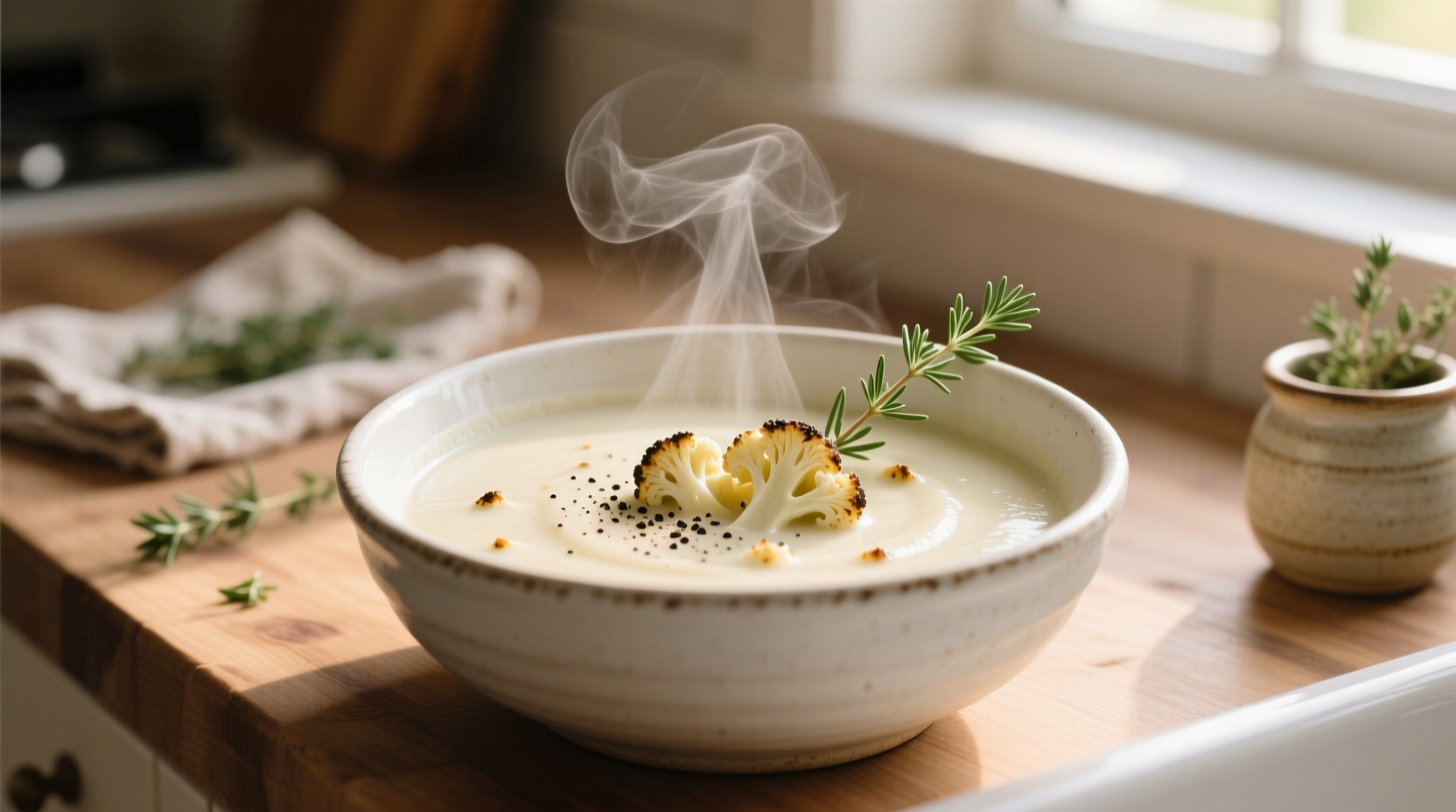This creamy vegetarian cauliflower soup recipe delivers a nutrient-dense, dairy-free meal ready in under 30 minutes. Packed with 4 grams of fiber and 77% of your daily vitamin C per serving, this simple preparation transforms humble cauliflower into a velvety comfort food that satisfies without compromising health goals.
Discover why this easy vegetarian cauliflower soup has become a staple in health-conscious kitchens worldwide. As professional chef Antonio Rodriguez explains, "Cauliflower's neutral flavor profile makes it the perfect canvas for building complex flavors while keeping nutritional integrity intact." Whether you're seeking gluten-free cauliflower soup options or a creamy cauliflower soup without dairy, this guide provides everything you need for restaurant-quality results at home.
Why This Soup Deserves a Spot in Your Weekly Rotation
Modern nutrition science confirms what traditional cooking has known for centuries: cauliflower offers exceptional versatility without sacrificing nutritional value. According to USDA FoodData Central, one cup of cooked cauliflower contains just 29 calories while delivering significant amounts of vitamins C, K, and B6. This healthy cauliflower soup for weight loss leverages those properties to create a satisfying meal that won't derail your wellness goals.
| Nutrient | Per Serving (1 cup) | Daily Value % |
|---|---|---|
| Calories | 142 | 7% |
| Fiber | 4g | 14% |
| Vitamin C | 55mg | 77% |
| Vitamin K | 18mcg | 15% |
Nutritional data sourced from USDA FoodData Central entry #11098, updated 2023
Your Step-by-Step Path to Perfect Soup
Phase 1: Smart Ingredient Selection
The foundation of exceptional vegetarian cauliflower soup begins at the market. Choose cauliflower heads with tight, creamy-white florets and fresh green leaves. Avoid any with brown spots or separation between florets. For the best vegetarian soup for cold weather, select in-season cauliflower (fall through early spring) when flavor and texture peak.
Professional chefs recommend these essential components:
- Cauliflower (1 large head) - provides creaminess without dairy
- Yellow onion (1 medium) - builds flavor foundation
- Garlic (3 cloves) - adds aromatic complexity
- Vegetable broth (4 cups) - use low-sodium for control
- Nutmeg (1/8 tsp) - enhances natural sweetness
Phase 2: Flavor Development Techniques
"Most home cooks rush the sweating process," notes Rodriguez. "Taking 8-10 minutes to properly soften onions without browning creates the flavor base that separates good soup from exceptional." Follow these professional techniques:
- Sauté onions in olive oil over medium-low heat until translucent (8-10 minutes)
- Add minced garlic and cook 1 minute until fragrant
- Stir in cauliflower florets, broth, and seasonings
- Simmer covered for 15 minutes until cauliflower pierces easily with fork
Phase 3: Achieving Perfect Texture
The secret to creamy cauliflower soup without dairy lies in proper blending technique. Never skip this critical step:
- Cool soup slightly before blending to prevent pressure buildup
- Fill blender only halfway with hot liquid
- Hold lid with towel while starting at low speed
- Blend in batches until completely smooth (1-2 minutes per batch)

Avoid These 3 Common Mistakes
Even experienced cooks stumble with these pitfalls when preparing vegetarian cauliflower soup:
Mistake #1: Overcooking the Cauliflower
Exceeding 15 minutes of simmering breaks down cauliflower's structure, creating a watery texture that won't emulsify properly. Set a timer and check for fork tenderness at 12 minutes.
Mistake #2: Adding Cold Liquid to Hot Blender
This creates dangerous steam pressure that can cause hot soup to erupt. Always let soup cool 5 minutes and fill blender only halfway, as recommended by the FDA's food safety guidelines for handling hot liquids.
Mistake #3: Skipping the Resting Period
Allowing blended soup to rest for 10 minutes before serving lets flavors marry and texture stabilize. This quick vegetarian meal preparation tip transforms good soup into exceptional.
Customize for Your Dietary Needs
This base recipe adapts beautifully to various requirements while maintaining its healthy cauliflower soup for weight loss credentials:
| Dietary Need | Modification | Flavor Impact |
|---|---|---|
| Lower calorie | Reduce olive oil to 1 tsp | Slightly less richness |
| Higher protein | Add 1/2 cup white beans before blending | Creamier texture, nutty notes |
| Keto-friendly | Add 1/4 cup coconut cream after blending | Tropical undertones |
Storage and Reheating Science
Proper storage maintains both safety and quality of your vegetarian cauliflower soup. According to the USDA Food Safety and Inspection Service, cooked soup remains safe for 3-4 days in the refrigerator when stored in airtight containers. For optimal texture:
- Cool soup completely before refrigerating (prevents condensation)
- Store in containers no more than 2 inches deep (promotes even cooling)
- Reheat gently over medium-low heat (boiling degrades texture)
- Add splash of broth when reheating (compensates for absorption)
Freezing extends shelf life to 3 months. Freeze in portion-sized containers with 1/2 inch headspace for expansion. Thaw overnight in refrigerator before reheating.
Why This Soup Works for Modern Lifestyles
Busy professionals increasingly seek quick vegetarian meal preparation that doesn't sacrifice nutrition. This vegetarian cauliflower soup delivers on multiple fronts:
- Time efficiency - 25 minutes from start to finish
- Nutritional density - packed with vitamins and fiber
- Meal flexibility - serves as standalone meal or side
- Cost effectiveness - uses affordable, seasonal produce
"The beauty of this recipe," explains Rodriguez, "is how it transforms a humble vegetable into something extraordinary through proper technique rather than expensive ingredients. That's real culinary intelligence."











 浙公网安备
33010002000092号
浙公网安备
33010002000092号 浙B2-20120091-4
浙B2-20120091-4